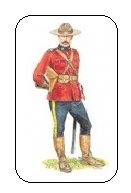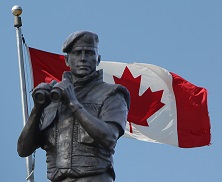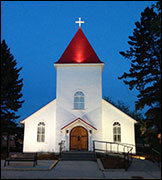True and Fascinating Canadian History
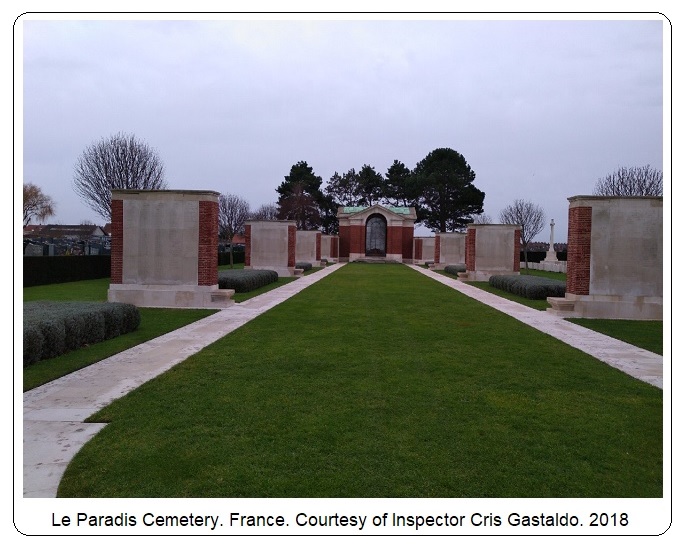
Vet of the Month: January, 2018
Reg.#12795, Constable William Archibald Willison
RCMP Vets. Ottawa, ON
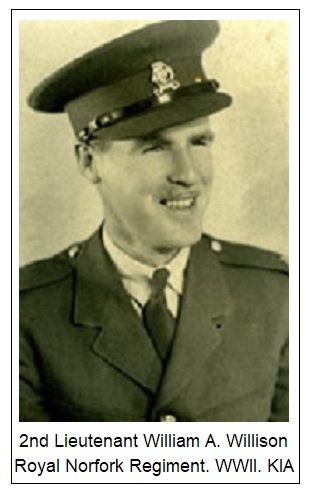
In the English language, tragedy is a word which has no restrictions or walls to keep it tightly contained. It is not a commodity that can be poured out like water little by little into smaller portions. To the contrary, tragedy is a drama which blankets everyone in its wake like a full, complete overcast and black sky with heavy rain which only spells doom.
The short story which follows is an unbelievable tragedy. It came to my attention recently through my friend RCMP Veteran and Historian Ric Hall of Vancouver, BC. Ric wrote to say, "My interest in this particular event in Europe all began when I noticed a small note in the RCMP Quarterly magazine dated July, 1940 which read, "... former RCMP William Archibald Willison who once served at "G" Division HQ as a Sub-Constable was reported missing during WWII while serving as a Lieutenant in the Norfolk Regiment with the British Expeditionary Force (B.E.F.) operating in northern France."
At the time in Canada, uncertainty and fear surrounded the British soldier's welfare especially the men of the Royal Norfolk Regiment who were reported to be fighting and possibly trapped near Dunkirk. Ric decided to seek out more information about Constable Willison's participation in WWII. Here, the tragic story of the Royal Norfolk Regiment and former Constable William Archibald Willison is told.
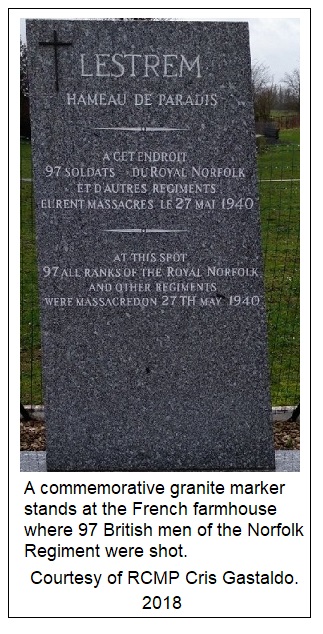
Reg.#12795, Constable William Archibald Willison grew up in Toronto, ON. He was the only son of a Canadian family, and from a young age he thought about the possibility of a military career. In 1935, however, he joined the RCMP in Ottawa, and after Basic Recruit Training at 'Depot' in Regina, SK., William Willison was posted back to Ottawa. Here, he was attached to the administration arm of the Force which was responsible for providing and transporting ordinary needs such as food, clothing and supplies to RCMP members serving in the far northern posts of Canada.
It is not known for sure, but perhaps William Willison heard rumours of the impending war, so after a two year stint in the RCMP he left the Force. He then joined the Governor-General's Guard, and when Germany invaded Poland in 1939, the Canadian Army was mobilized and William Willison volunteered as an Officer in the Royal Norfolk Regiment. Just prior to leaving for overseas, he married in Toronto, and within three months he was in Europe. It was war.
Briefly, the place was Dunkirk -- a scene once steeped in tragedy -- today it remains a small and historic city on the northern coast of France. In the midst of WWII and the Battle of France, the British Expeditionary Forces (BEF) were relentlessly pushed back towards Dunkirk while retreating from the Nazi forces in advance formation towards them.
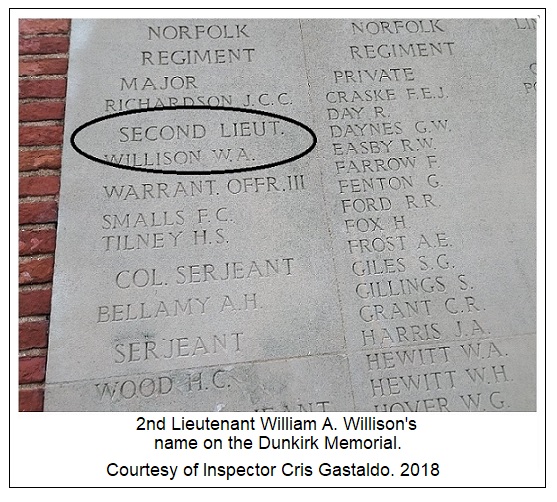
In the midst of the fire and fury, Dunkirk stood as the final defence point for France. Dunkirk was, at the same time, the evacuation area for the Allied forces who could only be saved by a miracle if ships were available to rescue them and the retreating soldiers were to safely reach the shores of England.
It was the responsibility of the Royal Navy to arrange the evacuation of the British and Allied troops at Dunkirk, however, Britain was afraid of losing their Navy to the German Air Force, so a plea and urgent call of action was sent out and hundreds and hundreds of small boats and pleasure craft responded. It was May 26th, 1940. The evacuation was underway. It was reported that, "On the first day only 7,669 Allied soldiers were evacuated, but by the end of the eighth day, 338,226 of them had been rescued by a hastily assembled fleet of over 800 boats. When it ended on June 4th, about 198,000 British and 140,000 French and Belgian troops had been saved." (Britannica.com). If the boat owners had not so bravely responded to the plea for help, the plan of evacuation would have failed and the soldiers on the Dunkirk beach would surely have all perished.
At the same time as the Allied evacuation, soldiers of the 2nd Battalion, the Royal Norfolk Regiment, had become isolated from their Regiment -- trapped-- -- at one point, little hope was held that they could reach Dunkirk and be safely evacuated from the beaches along with thousands of other men.
In a newspaper article printed in 2000, journalist Robert Lee Hotz wrote in the Los Angeles Times that for awhile, the 2nd Battalion occupied and defended a farmhouse against an attack by Waffen - SS forces in the village of Le Paradis.
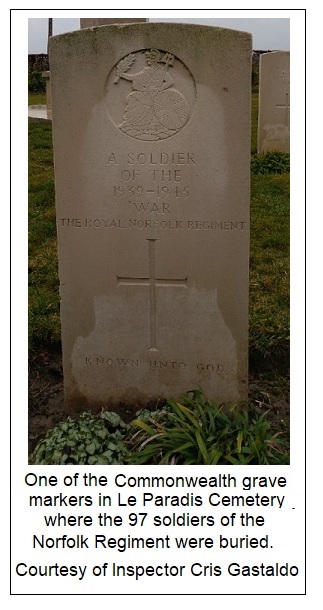
After running out of ammunition, the defending soldiers of the 2nd Battalion surrendered to the German troops. Later, the German Army led the 99 soldiers across the road to a wall at a farmhouse and shot all of them -- an event even under war conditions which is unimaginable.
After their death, the Royal Norfolk soldiers were buried in a shallow pit. Although injured, two soldiers survived the shooting attack by hiding in a pigsty only to be discovered later by the farm's owner. The two were captured and made POW's.
Former Constable then 2nd Lieutenant William Willison was among the soldiers shot and killed. He was 23 years of age.
After the war, the German Officer In Charge, Fritz Knöchlein was located, tried and convicted by a war crimes court, with the two British soldier survivors acting as witnesses against him. For his part in the massacre, Knöchlein was executed in 1949.
In early January 2018, RCMP Inspector Cris Gastaldo had the opportunity to visit Dunkirk, and the farmhouse where the British soldiers were killed as well as the French Cemetery, Le Paradis, where the soldiers were later buried. The photos in this story were courtesy of Inspector Gastaldo.
In the photo immediately below, Inspector Gastaldo stands at the Royal Norfolk Soldiers Commemorative Monument. In the red circle one can also see the plaque on the wall of the barn where the soldiers were gunned down. The property is presently private land with a fence protecting it.
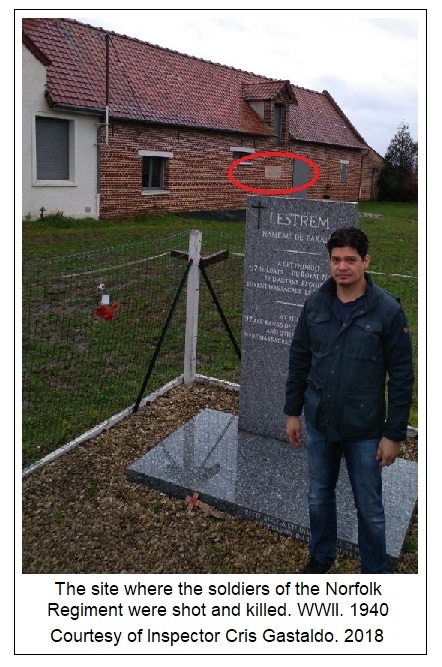
More often than just on November 11th each year, all Canadians should try to recall the efforts and the sacrifice these special Canadian soldiers made so that we could live in peace.
This short story was a moment to pay special homage to Lieutenant William A. Willison and the men of the Royal Norfolk Regiment who died under very tragic and unusual WWII circumstance. The bodies of the Royal Norfolk were exhumed by the French in 1942 and buried in Le Paradis War Cemetery. (Top of page photo). William Willison's body too was unidentified.
Prior to leaving for Europe with the Royal Norfolk, William Willison was married. After hearing the fateful news of her husband in 1942, William Willison's wife took her own life.
I wish to thank Vancouver RCMP Vet Ric Hall for the background information which he provided for this story and also to Inspector Cris Gastaldo for the photos which he kindly provided.
Reporting from Fort Healy,
J. J. Healy
January 23, 2018
Britannica.com: 2018
Hotz, Robert Lee. The Los Angeles Times. 2000
The Quarterly. RCMP magazine. July, 1940.
